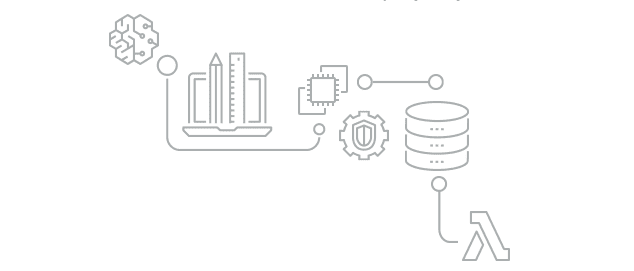An Introduction to Amazon Web Services
Cloud computing has developed and grown in popularity in the last 13 years, and shows no sign of slowing down. AWS have progressed to create several different models and deployment strategies in order to appeal and meet the specific requirements of professionals.
Each type of cloud service and deployment method provides you with different levels of control, flexibility and management. Understanding the differences between IaaS, PaaS and SaaS as well as what deployment strategies you can use, can help you decide what set of services is right for your needs.
Three main updates have been made to the AWS service:
Three main updates have been made to the AWS service:
- Elastic Compute Cloud (EC2) was designed to make cloud computing easier for developers to use. It ensures a more secure, flexible compute capacity in the cloud
- Simple Queue Services (SQS) was designed as a pay-per-use web service for storing messages in transit between computers. It enables you to separate and scale micro services, distributed systems and severless applications
- Simple Storage Service (S3 cloud storage) is storage for the internet, designed specifically to make web-scale computing easier for developers.
Continue reading and find out why now is the time for you to start your career with Amazon Web Services.
Cloud Computing Models
Cloud computing is composed of three main models: IaaS, PaaS and SaaS. These sectors are what define on-demand availability of computer system resources – AWS combines the three models.
Infrastructure-as-a-Service
Infrastructure-as-a-Service (IaaS) is the first part of cloud computing - it allows users internet-based access to cloud storage. IaaS usually provides hardware, storage, servers and data centre space.
AWS’ IaaS provides you with the highest level of flexibility and management control over their IT resources - it's the base for more complex cloud computing and services.
AWS’ IaaS provides you with the highest level of flexibility and management control over their IT resources - it's the base for more complex cloud computing and services.
Platform-as-a-Service
Platform-as-a-Service (Paas) removes the need for organisations to manage the underlying infrastructure (hardware and operating systems) and allows them to focus on the deployment and management of applications. This allows companies to be as efficient as possible as it removes the concerns of resource procurement, capacity planning, software maintenance or patching.
Software-as-a-Service
Software-as-a-Service (SaaS) is a software distribution model where a third party provider hosts applications and makes them available to their customers over the internet. SaaS permits organisations to install and run software on their own computers or data centres - meaning businesses save a lot of money and resources.AWS' SaaS provides you with flexible payments, scalable usage, automatic updates and much greater accessibility than was previously available. Pay-as-you-go models, decreased need for maintenance and the ability to access software from anywhere with an internet connection means that cloud computing and SaaS provide a huge number of benefits to both large and small businesses.
Cloud Computing Deployment Models
Cloud Computing Deployment Models are for all users who want to make use of a computing resources on a subscription basis. It is an arrangement of certain cloud environmental parameters such as accessibility and ownership.Cloud
Applications are either created in the cloud or are adapted in order to run in and benefit from the advantages of cloud computing. If you want all parts of the application to run in the cloud, with Amazon you’ll be able to fully deploy all applications.Hybrid
A hybrid deployment is a way to connect infrastructure and applications between cloud based resources and existing resources that are not located in the cloud.The relationship between the cloud and existing infrastructure is probably the most common method of hybrid deployment – it aims to expand and develop organisations’ infrastructure into the cloud, whilst still incorporating cloud resources into the internal system.
On-premises
Often referred to as a ‘private cloud’, resources can be deployed on-premises using virtualisation and other resource management tools. On-premises deployment often fails to provide many of the benefits of cloud computing, however it is sometimes sought for its ability to provide more dedicated resources.Why choose Amazon Web Services?
There are several reasons why you should choose Amazon Web Services to enhance your infrastructure. The following explores what AWS that other platforms do not:
AWS has the most functionality and flexibility - more services and features than any other cloud provider. More than 165 fully featured services, over 40 services that aren't available anywhere else.
AWS acquires the fastest pace of innovation. Just last year, AWS released 1, 957 new services and features. It allows you to take advantage of the latest technologies to innovate, differentiate and deliver solutions fast.
AWS has the largest community of customers and partners, and the largest and most dynamic ecosystem. It is the most secure cloud computing environment at present, and its core infrastructure is built to satisfy the security requirements for military, global banks and other high-sensitivity organisations.
AWS already has the largest and most dynamic ecosystem, most likely because it is the most secure cloud computing environment and because its foundation was designed to comply with high-sensitivity organisations like the military and global banks.
AWS already has the largest and most dynamic ecosystem, most likely because it is the most secure cloud computing environment and because its foundation was designed to comply with high-sensitivity organisations like the military and global banks.
AWS has the most functionality and flexibility - more services and features than any other cloud provider. More than 165 fully featured services, over 40 services that aren't available anywhere else.
AWS acquires the fastest pace of innovation. Just last year, AWS released 1, 957 new services and features. It allows you to take advantage of the latest technologies to innovate, differentiate and deliver solutions fast.
AWS has proven to be the most operational expertise - delivering cloud services for over a decade to millions of customers on an international scale, running a wide variety of cases and has the most operational experience at a greater scale than any cloud provider.
AWS is being utilised by more and more businesses every day and these businesses are benefiting greatly from the services AWS provides. Businesses who use AWS to manage their infrastructure have saved money, time and resources and focused their energies on the growth and development of their businesses.
As one of the fastest growing cloud platforms in the world - and it shows no signs of slowing down - and businesses increasing their reliability in cloud services, the increasing demand for certified professionals who are up-to-date with cloud security and maintenance is growing rapidly.
If you work in IT or cyber security and want to furher your career, Firebrand offer a variety of AWS certifications. Our all-inclusive courses means you'll sit your exams in a distraction-free environment, and return to the office a certified AWS practitioner.
Get AWS certified, fast, with Firebrand Training.
Get certified, fast
As one of the fastest growing cloud platforms in the world - and it shows no signs of slowing down - and businesses increasing their reliability in cloud services, the increasing demand for certified professionals who are up-to-date with cloud security and maintenance is growing rapidly.
If you work in IT or cyber security and want to furher your career, Firebrand offer a variety of AWS certifications. Our all-inclusive courses means you'll sit your exams in a distraction-free environment, and return to the office a certified AWS practitioner.
Get AWS certified, fast, with Firebrand Training.


